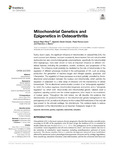Mostrar o rexistro simple do ítem
Mitochondrial genetics and epigenetics in osteoarthritis
| dc.contributor.author | Rego-Pérez, Ignacio | |
| dc.contributor.author | Durán-Sotuela, Alejandro | |
| dc.contributor.author | Ramos-Louro, Paula | |
| dc.contributor.author | Blanco García, Francisco J | |
| dc.date.accessioned | 2020-03-10T10:27:52Z | |
| dc.date.available | 2020-03-10T10:27:52Z | |
| dc.date.issued | 2020-01-17 | |
| dc.identifier.citation | Rego-Pérez I, Durám-Soutela A, Ramos-Louro P, Blanco FJ. Mitochondrial genetics and epigenetics in osteoarthritis. Front Genet. 2020;10:1335 | es_ES |
| dc.identifier.issn | 1664-8021 | |
| dc.identifier.uri | http://hdl.handle.net/2183/25145 | |
| dc.description | Review | es_ES |
| dc.description.abstract | [Abstract] During recent years, the significant influence of mitochondria on osteoarthritis (OA), the most common joint disease, has been consistently demonstrated. Not only mitochondrial dysfunction but also mitochondrial genetic polymorphisms, specifically the mitochondrial DNA haplogroups, have been shown to have an important influence on different OA-related features, including the prevalence, severity, incidence, and progression of the disease. This influence could probably be mediated by the role of mitochondria in the regulation of different processes involved in the pathogenesis of OA, such as energy production, the generation of reactive oxygen and nitrogen species, apoptosis, and inflammation. The regulation of these processes is at least partially controlled by the bi-directional communication between the nucleus and mitochondria, which permits the regulation of adaptation to a wide range of stressors and the maintenance of cellular homeostasis. This bi-directional communication consists of an “anterograde regulation” by which the nucleus regulates mitochondrial biogenesis and activity and a “retrograde regulation” by which both mitochondria and mitochondrial genetic variation exert a regulatory signaling control over the nuclear epigenome, which leads to the modulation of nuclear genes. Throughout this mini review, we will describe the evidence that demonstrates the profound influence of the mitochondrial genetic background in the pathogenesis of OA, as well as its influence on the nuclear DNA methylome of the only cell type present in the articular cartilage, the chondrocyte. This evidence leads to serious consideration of the mitochondrion as an important therapeutic target in OA. | es_ES |
| dc.description.sponsorship | Instituto de Salud Carlos III; CIBERCB06/01/0040 | es_ES |
| dc.description.sponsorship | Instituto de Salud Carlos III; RETIC-RIER-RD16/0012/0002 | es_ES |
| dc.description.sponsorship | Instituto de Salud Carlos III; PRB2-ISCIII-PT17/0019/0014 | es_ES |
| dc.description.sponsorship | Instituto de Salud Carlos III; PI14/01254 | es_ES |
| dc.description.sponsorship | Instituto de Salud Carlos III; PI16/02124 | es_ES |
| dc.description.sponsorship | Instituto de Salud Carlos III; PI17/00210 | es_ES |
| dc.description.sponsorship | Instituto de Salud Carlos III; (CPII17/00026) | es_ES |
| dc.language.iso | eng | es_ES |
| dc.publisher | Frontiers | es_ES |
| dc.relation.uri | https://doi.org/10.3389/fgene.2019.01335 | es_ES |
| dc.rights | Atribución 3.0 España | es_ES |
| dc.rights.uri | http://creativecommons.org/licenses/by/3.0/es/ | * |
| dc.subject | Mitochondria | es_ES |
| dc.subject | Genetics | es_ES |
| dc.subject | Epigenetics | es_ES |
| dc.subject | Osteoarthritis | es_ES |
| dc.subject | Methylation | es_ES |
| dc.title | Mitochondrial genetics and epigenetics in osteoarthritis | es_ES |
| dc.type | info:eu-repo/semantics/article | es_ES |
| dc.rights.access | info:eu-repo/semantics/openAccess | es_ES |
| UDC.journalTitle | Frontiers in Genetics | es_ES |
| UDC.volume | 10 | es_ES |
| UDC.issue | 1335 | es_ES |
Ficheiros no ítem
Este ítem aparece na(s) seguinte(s) colección(s)
-
GI-GIRS - Artigos [97]
-
INIBIC- REUMA - Artigos [184]






